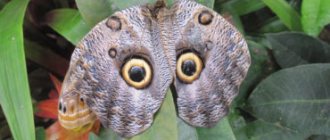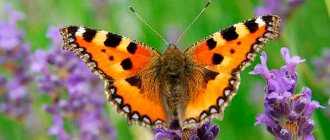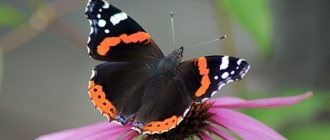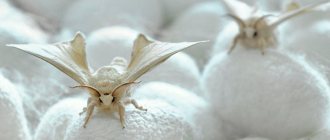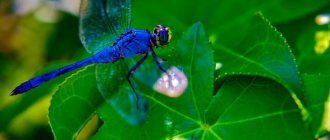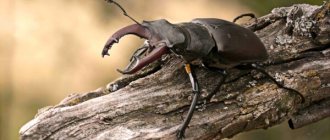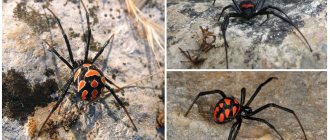Origin of the species and description
Photo: Mourning Butterfly
The species belongs to the diurnal butterflies of the nymphalid family. The Russian name Lepidoptera is associated with the dark color of the insect. In the West, the butterfly is better known under the name “mourning mantle”, in France its name is translated as “sorrow”, in Poland it is called the “gardener-complainer”. It owes its Latin name Antiopa to the queen of the Amazons, Antiope.
Interesting fact: Naturalist Carl Linnaeus named the butterfly in honor of the daughter of the god Nyctaeus. She gave birth to twins from Zeus, but was afraid of her father's rage and fled to the Peloponnese. Nikteus ordered his brother to find and kill his daughter. He persuaded her sons to tie the fugitive to the horns of a fierce bull. At the last moment, the twins learned that it was their mother in front of them and the murder had not been carried out.
According to one version, mourners got their name due to the similarity with the color of the cape of professional mourners, a common profession in the 15th century in Europe. After 300 years, the moth became a popular symbol of mourning among European nations.
Video: Mourning Butterfly
There are many subspecies dependent on temperature indicators. Under the influence of extremely low or, on the contrary, high temperatures, many forms arise, such as, for example, hygiaea Heydenr. The subspecies lacks blue eyes and the light border along the edge of the wings is wider.
Popular message topics
- Inedible mushrooms
All mushrooms can be divided into edible, conditionally edible, inedible and poisonous. Inedible mushrooms are those that, for one reason or another, are not suitable for food. For example, they have an unpleasant taste or odor, require long-term processing, - Didactic games
Didactics (from ancient Greek “instructing”) is directly related to upbringing and education. Ever since a person consciously began to pass on his knowledge to the younger generation, the need for training arose. - The Baptism of Russia
For many years, the entire territory of Kievan Rus supported paganism. The mentality of all Slavs was built solely on the contradiction between good and evil. The Slavs honored and worshiped a whole pantheon of gods. They worshiped gods such as
Appearance and features
Photo: Daytime mourning butterfly
The description of the mourning monastery is much more colorful than its name. The background of the wings is cherry or dark brown. The outer edge of the wings is sinuous, serrated, bordered by a wide yellow stripe. Along it there is a row of blue or light blue spots. At the top of the front wings there are two faded yellow spots.
- wingspan - 7-9 centimeters;
- The length of the front wing is 3-4.5 centimeters.
The lower parts of the wings are dark. In wintering individuals the border is much lighter. This is due to the fact that the color fades during wintering. The lighter color is not associated with seasonal forms. In butterflies living in the Far East, the border remains yellow. Sexual dimorphism is not expressed.
Interesting fact: The color of the moth depends on the weather conditions in which the pupa developed. Very high or extremely low temperatures cause shock and hormonal changes occur in the body. The brown tone becomes darker and blue strokes may be absent.
For the nymphalidae family, a protective color is characteristic of the underside of the wings. This side of the mourning dress is brown with black strokes and a light border. This color serves as a camouflage for the moth against the background of tree trunks and branches.
The body of the insect is oval-shaped and dark brown in color; there are three pairs of thin legs on which taste buds are present. On the head there are long club-shaped antennae as an organ of touch and a proboscis. The moth has 4 eyes: 2 of them are in the parietal zone and 2 on the sides.
Do you know what a mourning butterfly looks like?
The most spectacular and largest representative of the Nymphalidae family of the order Lepidoptera is the mourning butterfly. This flyer, widely distributed throughout Eurasia, with the exception of the tropics, is absent only in the territory of Mediterranean states, but at the same time, some individuals fly into tundra territories. Once brought to America, the mourning plant has spread from Canada to Mexico.
For unknown reasons, in the forties of the 20th century, the number of individuals of mourning birds decreased sharply. In this regard, in 1997 it was included in the Red Book of the Smolensk Region in the 3rd category, which includes species distributed in limited areas that are at risk of extinction if natural or anthropogenic conditions change.
Appearance The mourner is a butterfly that got its name due to its color. Its colors are so memorable that it leaves a huge impression for many years. The most accurate description of what the mourning butterfly looks like was described by S.T. Aksakov. Shiny, covered with a large amount of colored pollen, velvety dark brown, coffee, and at a certain angle, dark purple wings are trimmed with a white or yellow jagged border, along which there are bright blue spots. The wingspan of the butterfly reaches 7-10 cm. Like all nymphalids, the mouth of butterflies is a proboscis, which curls into a spiral and unfolds when the butterfly feeds. Its front legs are short and lack claws.
Origin of the name Carl Linnaeus, knowing what the mourning butterfly looked like, gave it the name antiopa in 1758, in honor of the heroine of Euripides' tragedy, which tells about the suffering and troubles that befell Antiope, the daughter of the Theban king Nikteus, seduced by Zeus, who appeared in the form of a satyr, and gave birth he has two twins in his marriage to Epopey.
While studying mourning birds, scientists paid attention to the influence of external temperatures prevailing during the development of the pupa on the subsequent intensity of the color of the insect’s wings. Depending on the climatic conditions of its habitat, there are differences in how the mourning butterfly looks - the color of the wing darkens, the size of the blue spots decreases, the density of the black coating on the border changes
Thus, overwintered butterflies that fly out of their wintering grounds at the beginning of spring have an almost white border.
However, this does not apply to butterflies that wintered in the East - they have a yellow border. In July-September, the new generation of mourners, whose pupae developed in the warm season, have a bright yellow border.
Development: In June, the female lays up to 100 eggs. The caterpillars hatch in June-July and stay in dense groups until the pupation period. What a mourning butterfly looks like when it is in the caterpillar stage is familiar to many. Black with white small dots and bright red spots (up to 7 pieces) between the thorns, the caterpillars often crawl along the leaves of birch, alder, maple, ash and other plants that serve as their food. The pupal stage of development is about 11 days. The butterfly feeds mainly on tree sap, so it can often be found on birch trees during the period of intense sap formation.
Where does the mourning butterfly live?
Photo: Mourning butterfly from the Red Book
The species is widespread in the Palearctic. Moths are accustomed to life in temperate climates. Therefore, they cannot be found in tropical areas. Insects do not go further than 68 degrees north latitude. Mourning birds live in England, Norway, and Germany. Migrating individuals have been observed on the shores of the Arctic Ocean.
The species is distributed in Japan, throughout Europe and Asia, North America, and northern Africa. Does not appear in Greece, southern Spain and on the shores of the Mediterranean Sea. Inhabits the Caucasus and Carpathian mountains, with the exception of the Black Sea coast. The species is absent on the Crimean Peninsula, but vagrant individuals can be found.
The insects were artificially brought to North America, and from there the butterflies spread from Mexico to Canada. Previously, the species lived throughout Europe, but after the end of World War II, their numbers declined sharply. In the tundra zone only migrating individuals are found, in forest-steppe and steppe areas - only in forest valleys.
With the onset of warm spring days, moths circle in clearings, gardens and meadows, the banks of reservoirs, and roadsides. For wintering, they look for reliable shelters, and when it gets warmer, they go outside to search for food and reproduce. They can be found at altitudes of up to 2000 m. Life expectancy under favorable conditions is up to one year.
Habitat of mourners
This insect has mastered the territory with a temperate climate. Not found in the tropics, nor in Greece and southern Spain. Nymphalids can live in mountains up to 2000 m above sea level . They live in the Caucasus and Carpathian mountains. The mourning woman inhabits the vast expanses of all Europe and Asia. Distributed in northern Africa and Japan. The butterfly was brought to North America and over time expanded its habitat from Mexico to Canada. Favorite habitats are forest edges, parks, gardens, meadows, and river banks.
What does the mourning butterfly eat?
Photo: Mourning Butterfly
Insects prefer overripe fruits - mainly plums and apples - to flower nectar. Moths are very attracted to the smell of sweet and sour fermentation. Clusters of these creatures can be found on damaged tree trunks on which tree sap has appeared. Butterflies especially like birch sap.
Having drunk the fermented juice, the moths become absent-minded and lose vigilance, so they become prey for birds and small rodents. Mourningbirds sit on flowers and field weeds. Creatures cannot obtain the lack of vitamins and microelements from pollen, so they make up for it from rotting carrion and animal excrement.
It is very important for moths to receive a sufficient amount of moisture, so it is vital for them to live near bodies of water. At the caterpillar stage, insects feed on food plants.
Their diet includes:
- hawthorn;
- rose hip;
- maple;
- Linden;
- alder;
- willow;
- poplar;
- nettle.
Often beautiful creatures can be found sitting on the ground near fruit-bearing trees, trying to feast on overripe fruits. They often choose cracked fruits so that they can easily extract the juice. Caterpillars spend most of their time searching for food. Before hibernating, they feed heavily, trying to eat as much vegetation as possible.
Characteristics
A characteristic feature of the individual is that they almost never feed on the nectar of flowering plants. Their diet usually consists of overripe fruits.
It is the aroma of fermentation that attracts the attention of these insects. They can cluster in a large flock around a tree that is releasing fermented sap. Most often, such liquid appears on damaged trunks.
It is worth noting that such butterflies were noticed when they feasted on birch sap. The surprising thing is that while eating fermented juice, insects completely lose their vigilance. They can sit on field weeds or flowers. In addition, such butterflies make up for the lack of microelements in their bodies from rotting remains and animal excrement. Such individuals simply need a huge amount of moisture. In other conditions, far from bodies of water, insects will not be able to survive. As mentioned earlier, birch sap is a real delicacy for mourners. As for caterpillars, in most cases they prefer food plants. Therefore, their diet is extensive. Caterpillars actively devour linden, alder, maple, hawthorn, rosehip, nettle, poplar and willow.
Features of character and lifestyle
Photo: Daytime mourning butterfly
With the onset of spring, butterflies emerge from secluded places, bask in the sun and look for food for themselves. In Russia they can be found only from July-August to October. When the nights become cool, insects begin to look for places to winter - cracks in stumps and trunks to protect themselves from the cold, basements of residential buildings.
The dark color of the wings helps insects easily hide in the grass. At the beginning of spring, only females can be found. They lay eggs and then die immediately. These individuals are capable of covering vast distances. Migration usually occurs in the fall in search of refuge.
Interesting fact: You can determine the cardinal directions by the mourning table. When a moth sits down to rest, it folds its wings and turns its back to the sun. In the morning the wings are turned to the east, at noon to the south, and in the evening they point to the west.
Mourning women appear in one generation. The subspecies have not been studied, but there are a lot of them. The brightness of their color depends on the time of year and habitat. When emerging from the cocoon in the spring, the insect will have a duller color. Immediately after birth they migrate. In hot weather, flights take several days. They depend on weather conditions.
Moths can live until June of next year, and in the mountains until August. In spring, butterflies live in places far from where they were born. In winter, many cannot withstand the frost and die. From the beginning of summer, the number of males predominates, then the inequality is eliminated.
UNUSUAL TASTES
Mourning nymphalids, like other nymphalids, have strange tastes: they often insert their proboscis into the excrement of various animals, overripe fruits, and wet banks of reservoirs, sometimes accumulating there in significant quantities. In this way, they replenish the supply of microelements they need. They are also attracted by the smell of fermentation: whole flocks of butterflies can be seen in the deciduous forest on fermenting birch sap in the spring and on damaged birch trees in the summer.
The mourning bird develops in one generation, but can be found throughout the summer. Adult butterflies overwinter, awaken as soon as the sun warms up, and fly already in April.
Caterpillar of the mourning butterfly.
The food plants of the mourning plant are birch, poplar, willow, and less commonly linden, alder, ash, maple, rose hips, and nettle. In May, females find suitable, usually small and medium-sized, trees and lay up to 100 eggs on their branches in dense circular clutches. Caterpillars can be found from June to July. They are also black, with spines and white dots. They are easily recognized by the eight red spots on their back. At first they stick together in broods, and then actively spread out and soon pupate.
After 11 days, in the second or third decade of July, butterflies emerge. They are brighter than spring birds that have overwintered, and the color of the border on their wings is yellow. For several days, “fresh” mourning birds fatten up on flowers, and then enter diapause (resting state) until mid-August. On warm August days they can be found in gardens, where they feed on overripe fruits. With the onset of cold weather, butterflies find suitable places for wintering and again fall into torpor, this time deeper - until spring.
Social structure and reproduction
Photo: Mourning butterfly in nature
Reproduction of the mourning moth is not much different from other moths. Pheromones are released from the back of the abdomen of females, which they use to attract males. The mating process lasts quite a long time - from 30 minutes to several hours in habitats. Males protect the territory from rivals.
Clutches contain about 100 eggs. The eggs are attached to the leaves or stems of food plants. Moths attach clutches around birch branches, forming rings. The caterpillars hatch in June. At birth, their length is only 2 millimeters. The caterpillars are black with white and red spots.
The brood is kept in a group. Caterpillars go through 5 stages of maturation. Each of them sheds. Amazon queens eat their skin. By the last stage, their length reaches 5.4 centimeters. Before pupation, individuals spread out. The pupae are attached to the branches of small trees upside down. Their length is about 3 centimeters. She will remain in this state for 11-12 days.
A few days after birth, insects enter diapause. Until the end of August they are in energy-saving mode. After this, the moths begin to feed intensively in order to accumulate energy reserves for hibernation. With the onset of the first cold weather, they hide and fall asleep.
Life cycle stages
The entire life cycle of a nymphalid lasts about 13 months . During this time, the butterfly goes through 4 stages of development : egg, larva, pupa, imago.
The female lays eggs in a dense, ring-shaped clutch that can contain up to 100 future butterflies .
After 2-3 weeks, the larvae hatch from them. This time falls in June or July. The length of newborn caterpillars is only 2 mm . The caterpillar's color is black with white speckles. There are red spots on the abdominal segments and the outer side of the metathorax. The spikes are black.
The development of larvae is characterized by 5 stages of maturation, at each of which molting occurs. The skin is eaten by the caterpillar itself. By the last stage, the larva increases in size to 54 mm . The caterpillars are kept in whole broods and disperse only before pupation.
The pupation process begins in July. The pupae, about 30 mm long, are attached to the branches of small trees with their heads down. They maintain this state for 11-14 days .
3-5 days after emerging from the cocoon, young individuals enter a state of dormancy and slowdown in vital activity, which lasts until the end of August. During the remaining time before the cold weather, butterflies feed intensively in order to gain enough energy for wintering.
Natural enemies of mourning butterflies
Photo: Mourning butterfly from the Beautiful Book
At all stages of development, the insect is surrounded by many enemies. Spiders, beetles or ants are not averse to eating moth eggs. Adults are affected by some species of birds, reptiles or small rodents. Although Lepidoptera have a camouflage color that turns them into a dried leaf, many individuals do not survive until spring, being discovered in shelters.
Caterpillars suffer from parasitic insects, Hymenoptera, which lay eggs directly in their bodies. Pests also lay eggs on food plants. Caterpillars eat leaves with clutches and parasitoids develop in the body of future butterflies, eating them from the inside. Riders are born already fully formed.
Parasites include ovoid, larval, ovolarval, pupal, and larval-pupal types. Some of them can paralyze the victim completely or certain parts of their body. Organisms live and develop at the expense of butterflies. As a result of their vital activity, lepidoptera die or become sterile.
Spiders and mantises hunt moths from ambush. They wait for beautiful creatures on flowers or catch them in their webs. Enemies include some species of wasps and ground beetles. Blackbirds and dragonflies hunt for mourning birds during flight. Toads and lizards lie in wait for butterflies on the ground and near water bodies.
Mourning maid
Nymphalis antiopa (Linnaeus, 1758)
Spreading
. On the territory of Moscow in 1990-2000. the species was found in 24 natural and green areas (2). During these years, the mourning box was also found among residential areas, especially near large natural areas, as well as on Garibaldi and Vavilov streets and even in the very center of the city on Manezhnaya Square. (2). During the revision period, the species was registered in the Kuzminsky forest in 2010 (3), Tsaritsyn in 2002-2005. (4), South Butovo in 2004 and 2007. (17), south of us. “Znamenskoye-Sadki” - regularly (5) and on the Krylatsky Hills in 2002 (6).
Number.
In the 1990s. the abundance of the species remained stable and even increased slightly (8), although within the Moscow Ring Road it was usually few and even rare (10). After 2001, only 5 habitats of the species are reliably known, and in Tsaritsyn after 2005 it was not found, despite regular surveys of the territory (3). In Znamensky-Sadki, 4-5 wasps are found. annually (5).
Habitat Features
. Overwintered butterflies appear in the spring on the first warm days and are found until mid-May. They are more often found in residential areas due to the abundance of suitable conditions for wintering here. The favorite habitat is sparse light birch forests in urban forests and forest parks, sometimes in separate groups of birch trees on lawns (8). In the forest, butterflies are usually found along wide roads and clearings, in large clearings. They often sit on the ground and trunks of birch trees; they gather on tree trunks around cracks with oozing sap, visiting them day after day, as well as on rotting fruit.
Eating fermented juice, they lose caution and timidity (15). They can also be found on flowering willows, inflorescences of thistle, thistle, etc. (15). The female places a group of eggs in a ring on thin branches (15, 17). Food plants for the caterpillars are birch (12), willow, aspen (14), and it is also possible to feed on elm (15) and apple trees (19). Caterpillars live in clusters in easily visible web nests (15). Before pupation they leave the common nest. They pupate in mid-July on a tree (15). Peak flight occurs at the end of July - beginning of August. At this time, most butterflies fly in urban forests and forest parks. A significant part of them winter in attics and basements of various buildings, in cracks, between window frames, in corners under the ceiling (8); in natural areas - in hollow trees, piles of brushwood and dead wood, under the loose bark of old stumps.
General Features of the habitat of the species of the complex.
Forest nymphalids generally do not need to feed on flowers; for carbohydrate nutrition they use the flowing sap of trees - birch, oak and other deciduous trees prone to sap, and replenish the deficiency of nitrogen and salts with organic solutions (rotting residues, animal excrement, etc. ), they drink a lot from puddles, and gather on damp ground. They live in forest clearings and edges. Butterflies of these species are characterized by a relatively scattered habitat and low population density. They fly well, are able to move long distances, and are to one degree or another confined to city blocks, which allows us to assume the existence of connections between habitats located in forest areas isolated by development, and to consider them as a single citywide population.
All three species of forest nymphalids are capable, under favorable conditions, not only of crossing, but also of populating well-greened courtyard areas, squares, and parks: the food plants of their caterpillars—birch and poplar, and, to a lesser extent, willow—are used in urban landscaping. Butterflies do not need to preserve bedding and forbs; they are not afraid of burning, trampling, mowing and flushing, because the entire development cycle takes place in the crowns of trees. However, populations of these species cannot exist independently, without connections with large forests, in urban areas. For Moscow, forest nymphalids are indicators of the preservation of large forests with a complex dynamic spatial structure of the vegetation cover, including glades, clearings and open spaces, areas of birch forests, aspen forests, willow forests, old oak forests and elm forests.
Negative factors
. In built-up areas, there is probably a lack of food for butterflies of all types and wintering sites for mourning birds in green areas due to the widespread regular removal of sap and hollow trees, leaf litter, lack of water and a shortage of areas with constantly moist soil. Massive drying out of trees along roads as a result of excessive use of deicing agents. Reducing the area of green spaces in residential areas during their reconstruction or construction of new facilities. For the common grasshopper and poplar ribbon grass - the absence of aspen in green areas and in residential areas, cutting down the crowns of poplars during deep pruning. In urban forests, there is a violation of the complex mosaic structure of forest communities required by these species, characterized by a significant diversity of age and species composition of trees; reduction in the area of aspen forests and a shortage of sap-bearing trees.
Security measures taken
. On the territory of Moscow, these species were subject to special protection from 1978 to 1996, in 2001 they were listed in the Red Book of Moscow with KR 5. The main key habitats of forest nymphalids are located in protected areas.
Changing the state of species.
The number of actual habitats of all three species decreased sharply during the revision period: if in the 1990s. each of them was noted in 15-20 territories, then during the revision period, the small waterspring was found only in 8 territories, the mourning grass and the poplar ribbon - in 3, the last one in 2006-2010. never registered. The CR of all three types changes from 5 to 2.
Necessary measures for the conservation of species.
Maintaining and restoring the natural dynamic mosaic of woody and herbaceous vegetation in large forest areas, ensuring the constant presence of glades, birch forests, aspen forests, and willow forests of different ages. Limiting sanitary felling to the removal of emergency trees. Conservation in green areas, incl. in residential areas, old hollow and sap trees. Stopping deep pruning of poplars. Reducing air and soil pollution to a level that is safe for woody vegetation and natural communities.
Information sources
. 1. Red Book of the Moscow Region, 2008. 2. Red Book of the City of Moscow, 2001. 3. A.E.Varlamov, l.s. and photo. 4. G.S. Eremkin, l.s. 5. P.V.Korzunovich, l.s. 5a. G.V.Morozova, l.s. 6. V.B. Beiko, l.s. 7. T.V.Levchenko, l.s. 8. Data from E.V. Mimonov. 9. Data from N.A. Sobolev. 10. M.Yu.Mironov, l.s. 11. E.V. Nikolaeva, l.s. 11a. Data from O.G. Gorbunov. 12. Osipov, Samodurov, 1988. 13. V.K. Shchelokov, l.s. 14. Sirotkin, 1976. 15. Heinriksen, Kreutzer, 1982. 16. B.A. Borisov, l.s. 17. Chinery, 1989. 18. Data and photos by A.A. Zarodov. 19. Korshunov, Gorbunov, 1995. Authors: E.V. Mimonov, N.A. Sobolev
AOF | 04/07/2015 18:39:55
Back forward
Population and species status
Photo: Mourning Butterfly
Before the outbreak of World War II, the number of moths was quite high. Lepidoptera were distributed throughout Europe. For reasons still unknown, the population declined significantly after the war. At the moment the level is low but relatively stable.
At the end of the 1960s, there was a massive surge in the number of insects in the Moscow region, in 1970 - in Novosibirsk, in 1985 - in the Tula region, and more recently - in 2008 in the Chelyabinsk region. Over its history, the species has experienced several fluctuations in numbers, either decreasing or increasing.
The population decline trend mainly depends on the destruction of the mourning bird's natural habitats. In the 1990s, moths were found in more than 20 natural and artificially created territories of the Moscow region. During this period, individuals could be found in residential areas, the Kuzminsky forest, and on the Krylatsky hills.
In the 1990s, the number recovered and even increased slightly, but it was rare to see it within the Moscow Ring Road. Since the early 2000s, only five habitats have remained. If before that there were many individuals in Tsaritsyn, then after 2005, no matter how much the territory was surveyed, no population could be detected.
Insects are important elements in the food chain. Larvae and pupae play an important role in bird nutrition. Thanks to adult individuals, rare species of small mammals, birds, amphibians and reptiles survive. They play an important role in flower pollination.
In built-up areas, mourners lack food and wintering places. Due to the drying out of trees along the roads, lack of water and moist soil, reduction of green spaces, and regular destruction of old hollow trees, a decrease in the number of insects is observed.
Quantity and protective measures
The number of butterflies is relatively stable. But there is a tendency to reduce it. The limiting factors characteristic of most insects are the destruction of natural habitats. In their history, mourners have experienced several periods of massive decline and increase in numbers. The population suffered significantly after World War II. Scientists have not found the exact cause of the death of the butterflies.
Attention. The mourning bird is listed in the Red Book of the Smolensk region as a rare species with a small number (III category).
In 1969, there was a surge in the number of butterflies in the Moscow region; in the 90s, they were found in 24 natural and artificial green areas of the city. In 2008, an unprecedented number of mourners were observed in the Chelyabinsk region. No special measures are taken to protect butterflies. The number of the species remains at a low but stable level.
